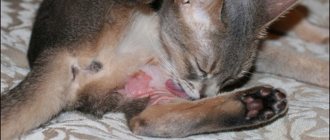Head shaking in cats can occur for a variety of reasons, both simple and more serious. In many cases, your cat's head bobbing may simply be a symptom of a benign temporary abnormality, such as a stressful situation or overheating. However, it can also be a sign of a more serious condition that may require veterinary intervention.
Sudden head shaking in felines can cause stress, but there is usually no cause for concern. In this article, we will look at the common causes of this unusual behavior in cats and possible solutions. Let's start!
Ear problems
The most common reason your cat nods his head is due to ear problems. It could be simply a buildup of wax causing discomfort or hearing problems, or it could be something more serious, such as an ear infection. An ear infection can throw your cat off balance, and rocking is her attempt to get better. This is usually accompanied by other symptoms such as vomiting and lack of appetite. Another possibility is ear mites or fleas, and persistent itching can be uncomfortable for your cat.
© shutterstock
Check your cat's ears thoroughly for wax buildup, fleas, or mites. Gently wipe away excess wax, but stay away from cotton swabs as they can damage your eardrums. If there are any signs of redness, swelling or pain, it could be an infection and you should take your cat to the vet.
Parasites and tremors
If a cat jerks its head strangely, the owner should first examine the ears. Involuntary head tremors are one of the main symptoms of otodectosis. The disease is also called ear scabies. It is caused by the activity of microscopic mites that infect the ears of animals that spend a lot of time outdoors.
Ear scabies are more often detected in small kittens and weakened older animals that often go outside. It is the decrease in one’s own immunity that is one of the factors predisposing to the development of such a disease.
An animal can only get the disease through contact with a street relative. Otodectosis is characterized by seasonality - the mite is most active in spring and the first half of summer. Specific symptoms of the disease:
- itching in the ears, which causes the cat to shake its head;
- thinning hair on the ears;
- restlessness, anxiety;
- the formation of crusts on the tips of the ears and in the shells;
- dark discharge instead of sulfur.
Long-term progression of the disease leads to hearing impairment. This is due to the formation of dense plugs that block the ear canal.
The cat, feeling discomfort, tries to get rid of microscopic parasites. The animal begins to scratch its ears, which is dangerous due to infection. Often, with a long course of otodectosis, there is an increase in body temperature, swelling of the ear and redness of the auricles. There may be discharge of pus and dark masses from the ears.
Treatment of the disease can be done at home. To do this, you need to purchase ear cleaning products and products with an antibacterial component. Amitrazine drops are most often prescribed.
We recommend the article: Poisonous plants for cats: how to help with poisoning?
The cat's ears must be cleaned with a cotton swab. With otodectosis, the wax becomes dense and difficult to clean off, so you can use a special product from a veterinary pharmacy, which is designed to soften the wax and facilitate the process of cleaning the ears.
After cleansing, the ear should be thoroughly wiped with a cotton pad and Amitrazine should be used. The drug is used three times a day, one drop. Repeated treatment is carried out after three days. If necessary, the drug can be used up to three times, maintaining the interval specified in the instructions between ear treatments. In order for the body to recover faster, it is necessary to introduce vitamin supplements into the diet to strengthen the immune system. As a rule, head tremors due to otodectosis disappear on the third day after the start of treatment.
Reaction to medications
A bad reaction to medications can cause cats to shake their head and, in severe cases, even cause seizures. Your cat may have a bad reaction to certain medications, which is quite common even with medications approved for cats. Never give your cat medications that are not prescribed or at least approved by your veterinarian, as this can cause serious side effects. Reactions to medications are often accompanied by other symptoms, such as nausea or diarrhea.
If your cat is taking medication and you suspect that this may be the cause of his head shaking, ask your veterinarian if another medication is available.
Ear infection in a cat
A cat's ear can become inflamed at all levels. This applies to the external auditory canal, structures of the middle, and also the inner ear. Such pathological changes in a cat’s ears occur as a result of infection, after suffering or poorly treated scabies, due to violation of the rules of care or cleaning of the ear canals, and even allergic reactions to household chemicals and food. Depending on the nature of the inflammatory process and its scale, a typical clinical picture for each type of inflammation will develop.
When the cat is inflamed, it constantly scratches its ear and shakes its head, its overall body temperature rises, coordination of movements is impaired and interest in food, games, and the outside world disappears. Such an animal most often tilts its head to the painful side, begins to hear poorly, does not respond to its name, and becomes clearly irritable. Inflammation in a cat's ears is a very serious disease. If left untreated, the animal risks remaining deaf or the pathological process can spread to the brain structures, which is often fatal.
Genetics
Although it is quite rare, your cat's genetics may play a role in her head bobbing. This is especially common among purebred animals, where poor breeding practices among a small gene pool can result in unhealthy animals.
A good example of this is the Burmese cat. These cats sometimes suffer from an inherited condition called hypokalemic polymyopathy, which is characterized by weakness of the neck muscles that can cause head shaking.
© shutterstock
Pathological signs
Minor rare scratching (2-3 times a day) and head shaking cannot be called odd: all living organisms scratch and shake their heads, cats are no exception. But if the cat begins to itch constantly and at the same time tears his ears with his paws with all his might, you should pay special attention to this. These symptoms are often accompanied by other alarming signs that should alert the pet owner. These are the signs:
- The animal behaves restlessly, gets irritated and nervous for no reason.
- The cat actively shakes its head, tilts it down or to the side.
- When scratching its ears, the pet emits a hiss or an angry purr, and meows pitifully and loudly.
- Scratching left bloody marks inside and around the ears.
- The cat is trying to rub its muzzle and ears on everything around it.
- It is possible that the cat's body temperature may increase.
- The animal does not allow its ears and head to be touched, reacting painfully to any touch.
- The inner surface of the ear becomes red or swollen.
- Various discharges flow from the ear.
- Brown crusts and ulcers appeared in the ear.
Have you noticed this behavior in your cat? So it's time to see the vet.
© shutterstock
Vestibular disease
Vestibular disease is characterized by sudden and somewhat severe disorientation in cats, which may be the cause of your cat's head bobbing. Common symptoms include falling or leaning to one side, bending or shaking the head, and often nausea and vomiting. This condition is caused by an abnormality in your cat's inner ear, the vestibular system, which is responsible for balance and coordination. The exact cause of this condition is not yet fully understood and diagnosis is made based on clinical signs.
The condition usually occurs suddenly and can occur in cats of any age. Although there is no specific treatment, your veterinarian will likely prescribe antibiotics or antifungal medications since there is likely some kind of infection in the inner ear. The condition is short-lived and usually goes away within a few days.
Symptomatic treatment
Physiological tremor does not require treatment.
To understand that a cat is shaking its head because it is in pain, it is important to observe it. The following signs should alert you:
- the animal not only shakes its head, but also actively itches (to the point of wounds and abrasions);
- pus or ichor flows from the ears;
- the cat does not lay its head on a certain side;
- the animal's appetite decreases or completely disappears;
- there is a shaky gait, movements are not coordinated;
- the cat meows loudly and pitifully or, on the contrary, becomes lethargic and tries to hide from prying eyes.
In case of pathological jerking of the head, the diagnosis must be made by a doctor. To do this, he will examine the cat's ears and take blood tests. If no external signs of pathology are found, the veterinarian will perform an ultrasound or computed tomography. After making the correct diagnosis, the specialist will prescribe the appropriate treatment:
- For the treatment of otodectosis, antiparasitic ear drops may be sufficient; for the treatment of otitis, antibiotics will have to be used.
- It is also best to entrust the removal of foreign bodies from the ear to a veterinarian. After the procedure, the specialist will treat the ear with antibiotics and prescribe drops that will help avoid infection.
- Antifungal therapy involves treatment with chlorhexedine (rinsing the ears with a solution) and treating the ears with Otibiovin drops. Veterinarians also prescribe internal administration of Ketokenozol. But it must be given to your pet strictly in the dosage recommended by the veterinarian.
- Dermatitis is treated with hydrogen peroxide and treatment with ointments that have astringent properties, for example, 2 percent silver nitrate. Dropping a few drops of novocaine into the ears will help relieve itching.
- If neoplasms occur, the issue of surgery is decided. Most often, the ear and hearing can be preserved when growths and tumors are removed.
- Neurological disorders and failure of one or another organ require specific treatment, which can only be offered by an experienced veterinarian.
- Multiple organ diseases and liver failure require treatment of the underlying disease. When recovery occurs, the tremor will go away.
Final thoughts
Although sudden head shaking in a cat can be alarming, there is usually no serious cause for concern. The problem is usually easy to fix at home, and your cat can quickly bounce back. However, if the problem persists or worsens and is accompanied by other symptoms, it is a good idea to take your feline to a veterinarian for a check-up.
Posted by Christian Adams An American expat living in Metro Manila, Philippines for over a decade, Christian is a lifelong cat lover and the proud father of two rescue cats, Trixie and Chloe. Both girls used to be among the crowds of homeless people who roam the cities and countryside. Three-year-old Trixie was rescued from a litter found under a neighbor's porch, and two-year-old Chloe was brought home by Christian's young son, Henry, who discovered the crying kitten in the parking lot.
Modern approaches to treating the disease
Before starting treatment, it is necessary to determine exactly why the cat is shaking its head and intensively scratching its ears. The nature of therapy will directly depend on the causes of the disease, its neglect and the individual characteristics of the animal’s body. If the main etiological factor in the occurrence of a pathological condition is an infectious agent, then it is advisable to prescribe antibacterial ear drops for external use with a wide spectrum of action to the animal. Parasitic infections are treated with antiparasitic drugs, and if allergies develop, systemic medications should be used.
In most cases, when a cat scratches its ears excessively, topical treatment is sufficient. Only advanced forms of otitis need to be treated with systemic medications. Surgical treatment is performed on sick cats extremely rarely - when there is a significant narrowing of the lumen of the ear canal, abscess formation, or the need to excise part of the affected tissue due to their necrosis.
What to do, how to help a cat depending on the problem at home
If you discover that your cat has ear problems, you can provide first aid to her at home. When otodectosis or sulfur plug occurs, it is possible to carry out all the treatment on your own.
In the first case, it is enough to buy drops at a pet store and carry out the course according to the instructions of the drug, and in the second, instill saline solution into the ear canal blocked by a plug several times a day for a week.
When treating a hematoma in an animal, the auricle is lubricated with absorbable ointments, such as Troxevasin and Troxerutin. It is unacceptable to try to open a hemorrhage yourself.
With otitis media, treatment on your own is impossible. As a last resort, it is permissible to clean the ear with a cotton swab moistened with hydrogen peroxide, followed by placing Levomekol ointment in the ear. Antibiotic injections are prescribed only by a veterinarian.
Briefly about the problem
Indeed, often such behavior indicates possible diseases. Therefore, you need to carefully ensure that the animal’s ears are always clean and healthy, and this requires attention and regular care. It is important to understand how often does a cat shake its head and scratch itself? Does this happen systematically?
Most often the answer will be - five times a day and unsystematically. That is, the animal wanted it, so it scratched itself. And then he can forget about his ears for the rest of the day, play calmly and behave like an ordinary and healthy cat. This is normal, because people often itch without thinking about it.
The following signs should be cause for concern:
- the pet itches regularly, for a long time and often;
- shakes his head towards the same ear;
- It scratches not just with its paw, but with its claws, tearing the skin.
In addition to this, the pet begins to navigate worse in space, rubs against the floor, and has a pronounced unstable gait. All this indicates illness, so you need to quickly go to the doctor.
Let's consider possible factors that cause deviations. They are usually classified into primary, secondary and predisposing.
Predisposition
Cats may be predisposed to ear diseases:
- congenital narrow auditory canal;
- incorrect structure of the auricle;
- trauma to the ear canal (for example, due to careless cleaning, fighting, etc.);
- incorrectly selected means for preventive treatment of the ears;
- excessive amount of earwax (a congenital pathology when the glands secrete too much secretion);
- neoplasms in the ear canals (polyps, granulomas).
Secondary factors (supporting)
Even if you have identified the disease in time and started treating it, it is important to take into account the presence of its secondary factors. If they are not eliminated, recovery will be significantly delayed. And they are as follows:
- altered bacterial flora of the ear canal (reproduction of streptococci). if the number of pathogens exceeds a certain limit, they lead to complications;
- due to inflammation, swelling, fibrosis or other problems may form;
- violation of recommendations for caring for your pet’s ears (incorrectly selected product, too frequent or careless cleaning).
Information for cat owners.
The cause of severe itching and external otitis in cats in 50% of cases is otodectosis. To treat otodectosis in cats, you can use antiparasitic ear drops , drops on the withers, or injections of an antiparasitic drug.
Antiparasitic ear drops must be instilled at least 3 times with an interval of 5-7 days (this is due to the development cycle of the tick). For example, your veterinarian may prescribe Bars Forte ear drops for cats . This drug has the widest spectrum of action against pathogens; has a therapeutic effect for otitis caused by both microbes and fungi; has an anti-inflammatory effect. According to reviews from owners , Bars ear drops for cats are indeed very effective, affordable and easy to use. However, remember, if you drop drops into dirty ears, the drug will not be able to penetrate deep into the ear canal, and accordingly, the drops may not be able to start working. This is another reason why it is better to do this procedure at a veterinary clinic for the first time. Remember that only with the correct use of Bars ear drops for cats or any other ear drops, the treatment will be effective and will not cause discomfort in the animal.
Drops on the withers have an excellent therapeutic effect. This is especially useful for animals that react negatively to ear cleaning and drops. However, these drugs are expensive.
If the lesions are severe, injections of an antiparasitic drug (ivermectin) may be required. The drug is administered subcutaneously 3 times with an interval of 10 days. This is a 100% way to get rid of ear mites. The disadvantage of this method of treatment is pain when administering the drug, and the need to visit the clinic for injections.
Attention! Otodectosis is very contagious in cats , so it must be diagnosed and treated only by specialists at a veterinary clinic, and not from photos on the Internet. The sooner you start professional treatment, the faster your pet will recover!
Main symptoms
To an attentive owner, the nature of ear discharge can tell a lot. And the cause for concern is the accumulation of a substance inside the ear with an unpleasant and pungent odor. Impurities of pus or blood indicate that the disease has progressed to a severe form.
In this case, the cat must be urgently shown to a specialist who will diagnose and prescribe appropriate treatment. Otherwise, more serious problems may arise - disruption of the integrity of the eardrum with subsequent deafness.
How to treat
To treat a disease, you first need to identify it. And the therapy itself will depend on why the disease occurred and how advanced it is. The doctor will also take into account the characteristics of the cat’s body.
Is it due to infection? The animal is prescribed special drops with a wide spectrum of action. Were parasites found? Special antiparasitic drugs are used. To treat allergies, systemic medications are used and complete abstinence from the product (or food) that caused the allergy is practiced.
At an early stage of the disease, therapeutic treatment is sufficient. Surgical interventions are required only if the ear canal has become too narrow or it is necessary to excise the affected tissue as a result of the development of necrosis.
Diagnostics
Diagnosis of vestibular diseases requires a thorough history and careful examination. To choose the direction of diagnosis, it is important to first determine whether it is a central or peripheral disorder. It is necessary to check both auditory tracts and eardrums along with an assessment of the neurological condition of the animal.
Basic laboratory tests include a complete blood count, blood chemistry panel, and urinalysis. Basic testing will also include tests for feline leukemia virus, feline immunodeficiency virus, and titers for feline coronavirus, toxoplasmosis, and cryptococcus. Evaluation of elevated immunoglobulin G titers and the presence of immunoglobulin M titers may be a sign of active toxoplasmosis infection.
X-rays of the head can help detect ear diseases by identifying changes in the tympanic bulla. However, x-ray is not a specific diagnostic method and does not show the soft tissues involved in the pathological process. New imaging techniques such as computed tomography (CT) or magnetic resonance imaging (MRI) are much better at localizing lesions in the ear or brain. MRI is particularly useful in detecting soft tissue lesions.
Because MRI is expensive, it is more often used to distinguish between central (brain) and peripheral (ear) disease after basic preliminary tests have been performed.
If encephalitis is suspected, cerebrospinal fluid (CSF) is taken for analysis. One of the most common causes of encephalitis is feline infectious peritonitis (FIP). FIP occurs primarily in cats under two years of age and is a progressive disease. The brain stem and spinal cord are the first to be affected. CSF analysis will demonstrate elevated levels of protein, predominantly globulins, and a moderate number of white blood cells, predominantly neutrophils or lymphocytes. Antibody titers or PCR virus presence may be inconclusive.
Sarcopid mites
If your cat's ears are shaking, this could be a sign that she has another type of mite. Such mites can spread not only in the ear area, but also in other parts of the cat’s body. They cause another feline disease, notoedrosis.
The head is affected first, then the entire body. The skin at the site of infection becomes dry and dense, covered with a crust, and the crust subsequently cracks.
To make an accurate diagnosis, you need to show the cat to a specialist. He will take a sample from the surface of the skin for analysis. Only the outermost layer from the inflamed area is scraped off; ticks can be seen there.
Both types of ticks provoke severe itching in the animal, forcing them to scratch the skin until it bleeds. Scabies that affects the ears can lead a cat to deafness or meningitis; in especially severe cases, the death of the pet can occur.











